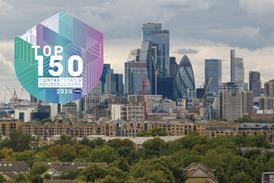Cast iron pipe manufacturer Saint-Gobain Pipelines has released the results of fire tests which show fire spreading downwards in plastic above-ground drainage pipes. Cast iron pipes tested in the same fire remained intact.
The company commissioned the tests in Germany in a bid to show that cast iron is a safer choice than plastic pipes. Plastic pipes and HDPE in particular are taking market share from cast iron as contractor-led value engineering exercises replace cast iron with cheaper materials.
Drainage design engineer Rod Green, MD of Green Consultancy, estimated that this happens on 50% of the major projects he is involved with.
The tests, carried out by MPA North-Rhine Westphalia Laboratory, compare cast iron pipes and fittings to EN877, an HDPE sanitary pipe system, a PVC sanitary pipe system and a twinned wall PVC sanitary pipe system. The plastic-based systems were fitted with the recommended intumescent fire collars and the cast iron systems were sleeved through the compartment walls.
Researchers started a fire on the middle floor of a three-storey building. The resulting video shows that fire collars stopped upward spread of fire, but molten drops spread fire downwards. After half an hour the PVC and HDPE pipes had been destroyed, the twin-wall pipe was badly damaged and the cast iron system remained intact.
Green, who spoke at a showing of the video for journalists in London last month, said that the tests showed fire collars did not stop fire spreading. He added that although plastic systems are often boxed out with one or two-hour fire-rated materials, pipes are left open in the spaces above false ceilings.
The results could be of particular interest for PFI jobs, since a fire on one floor could put several floors out of action if all the plastic pipes require replacament.
The Plastic Pipes Group of the British Plastics Federation issued a press release in response to Saint-Gobain’s video in which it points out that in 40 years there have never been any reports that the use of plastic pipes has lead to increased risk during a fire. It also says that the pipes were installed to German not British building regulations and that in the UK pipework is contained within fire-protected ductwork, rather than left exposed as in the tests.
Source
Construction Manager
Postscript
For a free copy of the video and information pack, call Saint-Gobain Pipelines on 0800 0282134 or call CIDDA 0121 6939909.





















No comments yet